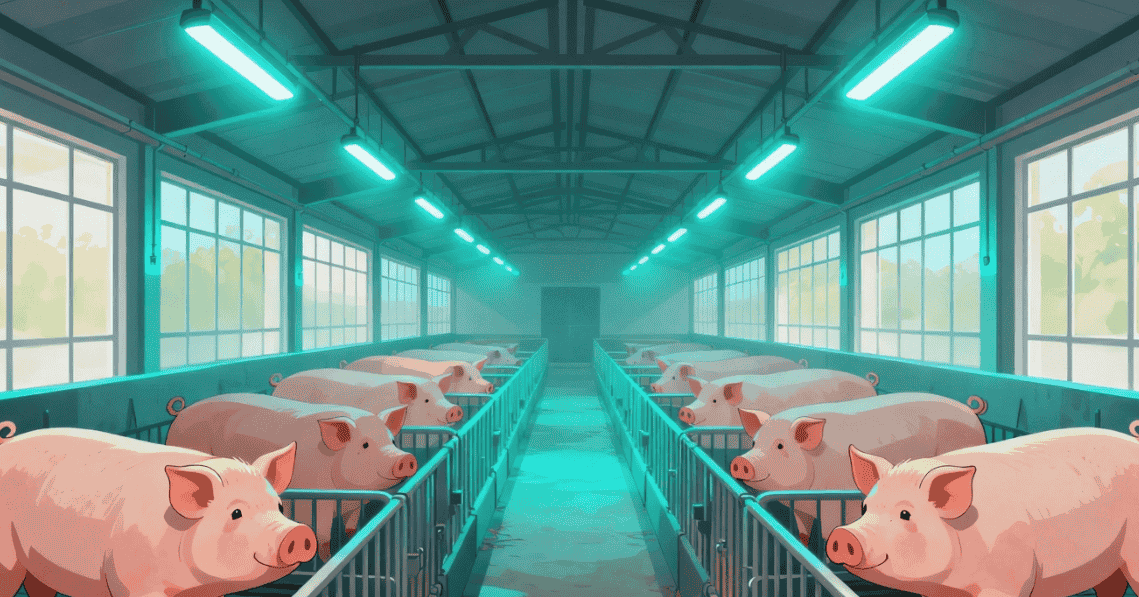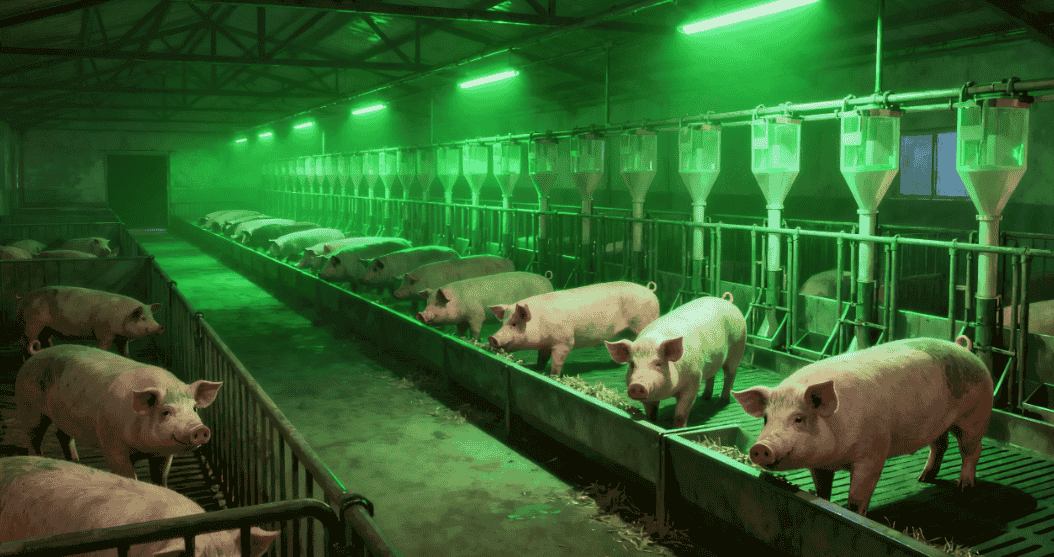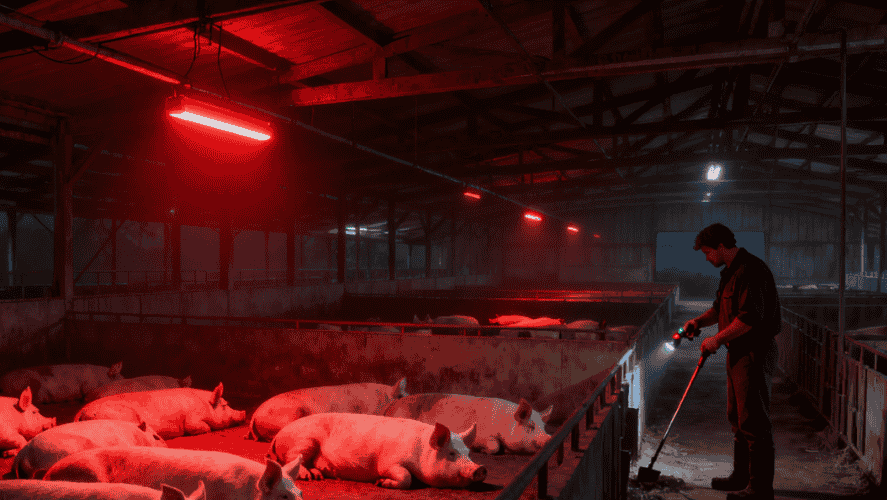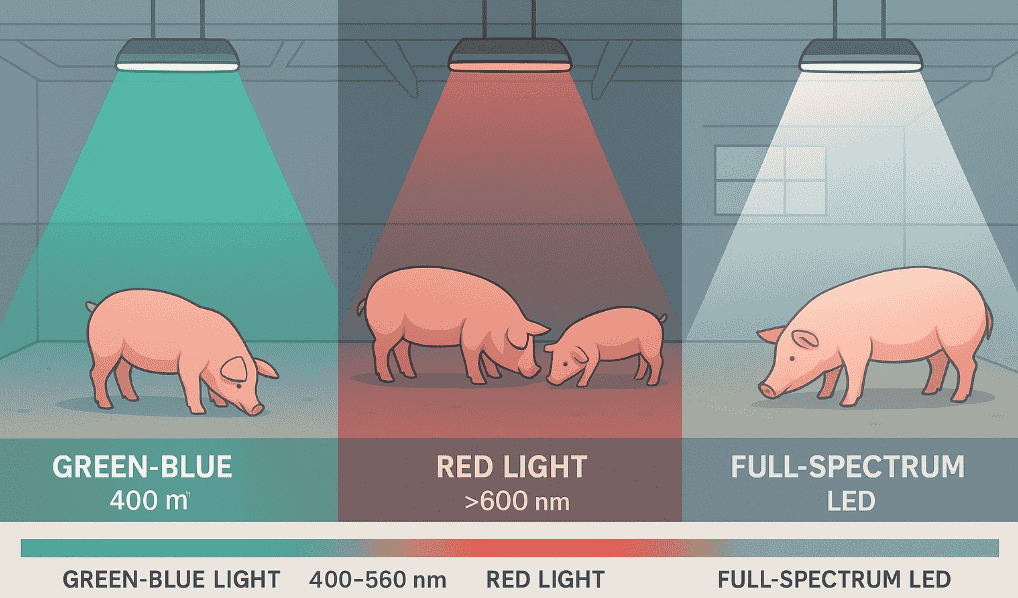Can Pigs See Green Light and Red Light?

Directory:
4. Practical Lighting Guidelines for Pig Housing
5. Comparison: Green Light vs. Red Light for Pigs
6. The Role of LED Spectrum in Pig Lighting
7. Practical Guidelines for Farmers and Integrators
8. Conclusion: Strategic Use of Green and Red Light in Pig Farms
Introduction:
Farmers and production managers frequently ask, “Can pigs see green light?” or “Can pigs see red light?” because the spectral quality of lighting has a direct impact on animal welfare, feeding behavior, and overall production efficiency. When designing lighting systems for pig housing, understanding how pigs perceive light goes beyond academic interest—it is a critical component of modern livestock management.
Unlike humans, pigs possess unique visual sensitivities that influence how they interact with their environment. By carefully selecting and tailoring light wavelengths to match these sensitivities, producers can create optimal lighting programs that support healthy growth rates, minimize stress and aggression, and enhance operational efficiency. Strategic lighting not only improves animal performance but also contributes to energy savings and facility sustainability, making it an essential consideration in the design of contemporary pig housing systems.
1. Can Pigs See Green Light?
Yes, pigs can see green light, and research indicates that their visual sensitivity peaks in the medium-wavelength range. Pigs have dichromatic vision, which means they primarily detect blue and green light, while their perception of longer wavelengths, such as red, is limited. Understanding this distinction is essential for designing effective lighting systems in modern pig housing.

Green light plays a crucial role in pig management for several reasons:
Visibility and Activity: Pigs respond more actively under green illumination, navigating their environment more confidently and displaying higher activity levels. This improved visibility can enhance monitoring, reduce injuries, and facilitate smoother daily operations.
Animal Welfare: Moderate-intensity green light contributes to reduced stress and encourages natural behavior patterns, supporting overall health and welfare. By aligning lighting with pigs’ visual capabilities, producers can foster a more comfortable and low-stress environment.
Feeding Efficiency: Green light has been shown to promote consistent feed intake, particularly in weaned pigs transitioning to solid diets. This helps maintain growth performance and supports efficient production cycles.
For practical applications, green LED systems are widely recommended for general pig housing, as pigs perceive green light clearly and effectively. In contrast, red light offers limited visibility for pigs and is less suitable for tasks that require active engagement or monitoring. Strategically implementing green lighting can therefore improve both animal performance and operational efficiency, making it a vital consideration for modern livestock facilities.
2. Can Pigs See Red Light?
The answer is nuanced. While pigs possess a limited ability to perceive red light, their sensitivity declines sharply at longer wavelengths above approximately 600 nm. To humans, red light appears bright and easily visible, but pigs often perceive it as dim or nearly invisible. This distinct difference in visual perception has practical implications for livestock management.
Despite this limitation, red light can be leveraged strategically in pig housing systems:
Night Inspections: Red lighting allows farm staff to move through barns during nighttime hours without disturbing the animals. Because pigs are less reactive to red wavelengths, operations such as health checks, cleaning, or equipment maintenance can be performed with minimal disruption.
Resting Behavior: The poor perception of red light by pigs effectively creates an environment closer to darkness. This encourages natural resting behavior, reduces stress, and lowers the likelihood of aggression during off-feed periods, contributing to overall animal welfare.
Limitations: It is important to note that exclusive reliance on red light is not recommended for daily management. Red wavelengths do not sufficiently support feeding activity, growth performance, or general activity levels, making them unsuitable as the primary lighting source in production areas.

In conclusion, while pigs can technically detect certain red wavelengths, the functional utility of red light in production settings is limited. Green and blue light remain far more effective for supporting visibility, feeding behavior, and overall performance, whereas red light is best reserved for specialized applications that prioritize minimal disturbance and rest periods.
3. The Science of Pig Vision
Pigs are dichromatic animals, meaning they perceive color differently from humans, who are trichromats. Their retinas contain two primary types of cones:
Short-wave cones (blue): Sensitivity peaks around 439 nm, enabling pigs to perceive blue light effectively.
Medium-wave cones (green): Sensitivity peaks around 556 nm, making green light particularly visible and functional for daily activities.
Absence of long-wave cones (red): This explains why pigs have limited ability to detect red light, which appears bright to humans but dim or nearly invisible to pigs.
Understanding this biology is critical for modern pig housing management. Questions such as “Can pigs see green light?” or “Can pigs see red light?” cannot be answered purely in terms of physics—they must be evaluated in the context of both animal physiology and production objectives.
4. Practical Lighting Guidelines for Pig Housing
Effective pig lighting is about more than simply illuminating the barn; it is a tool to align environmental conditions with the animals’ biological needs, enhancing welfare, growth, and operational efficiency.
Green and Blue Light (400–560 nm): Ideal for daily illumination, these wavelengths support feeding behavior, locomotion, and general activity. Proper use of green and blue light improves visibility and promotes consistent performance throughout production cycles.
Red Light (>600 nm): Red wavelengths are best reserved for nighttime inspections or low-activity periods. Because pigs perceive red light poorly, it allows caretakers to move through barns with minimal disturbance, encouraging rest and reducing stress-related behaviors.
Intensity: A minimum of 40 lux at pig eye level is generally recommended in most units (source: AHDB, 2019), ensuring sufficient visibility without overstimulation.
Uniformity: Avoiding dark spots and uneven illumination helps reduce aggression, improve feeding consistency, and maintain stable behavioral patterns.
Well-designed LED systems that balance green and blue wavelengths for daily operations, while strategically incorporating red light for inspections or rest periods, can deliver measurable benefits. Such lighting programs not only enhance pig welfare and growth performance but also optimize operational efficiency, reduce energy consumption, and support long-term facility sustainability.
5. Comparison: Green Light vs. Red Light for Pigs
When selecting lighting strategies for pig housing, it is important to consider how different colors are perceived by pigs and how they influence behavior, welfare, and operational efficiency. The following table summarizes the key differences between green and red light in practical farm applications:
| Light Color | Can Pigs See It Clearly? | Practical Benefits | Limitations | Farm Application |
|---|---|---|---|---|
| Green Light | Yes – pigs perceive it well | Supports feeding, activity, welfare | None significant if intensity is correct | General housing illumination |
| Red Light | Poorly perceived, appears dim | Night inspections, encourages rest, reduces stress | Not suitable for feeding/activity | Barn checks without disturbing pigs |
In conclusion, integrating green light for daily illumination and red light for targeted nighttime inspections allows producers to optimize both pig welfare and operational efficiency, making it a critical consideration for modern pig housing design.
6. The Role of LED Spectrum in Pig Lighting
While the question "Can pigs see green light?" ou "Can pigs see red light?" is central, the more practical issue is how LED lighting spectrum can be designed to align with pig vision. Modern LED systems allow precise control of wavelengths, ensuring animals receive the light they can actually perceive.
Green-blue spectrum (400–560 nm): Pigs respond well to this range, improving feed intake and movement.
Red spectrum (>600 nm): Perceived weakly by pigs, useful for calm nighttime conditions but not for daily activity.
Full-spectrum LEDs: Deliver consistent, uniform illumination, compensating for pigs’ dichromatic limitations while stabilizing growth performance.

This is where Ceramiclite livestock barn LED lighting systems demonstrate clear advantages. Unlike conventional fluorescent or incandescent bulbs, Ceramiclite's agricultural LEDs are engineered with optimized green-blue spectral peaks that match pig visual sensitivity, while still offering controllable red channels for night inspections. The result is a tailored lighting environment that supports both welfare and production outcomes.
7. Practical Guidelines for Farmers and Integrators
Based on field trials and academic research, the following lighting practices are recommended to optimize pig welfare and production efficiency:
Maintain 200 lux at piglet pen level during husbandry tasks to ensure visibility for both staff and animals.
Reduce to 80–120 lux in finishing units to promote calm behavior and reduce stress-related aggression.
Use dimmable LED systems to simulate natural sunrise and sunset, avoiding sudden light changes that can startle pigs.
Apply green-enhanced light during feeding and growth phases to support activity, navigation, and consistent feed intake.
Reserve red light for nighttime inspections or reproductive management tasks, allowing staff to work without disturbing resting animals.
8. Conclusion: Strategic Use of Green and Red Light in Pig Farms
To address the original question "Can pigs see green light?" ou "Can pigs see red light?" , the evidence is clear: pigs perceive green light effectively, while their sensitivity to red light is limited. This distinction is not merely academic; it has direct implications for farm management and facility design.
Green light should form the foundation of daily illumination in pig housing, supporting feeding behavior, movement, and overall welfare. Red light, by contrast, functions best as a specialized tool for nighttime inspections or low-disturbance management tasks. When used strategically, the combination of green and red lighting can balance operational efficiency with animal welfare objectives.
By aligning lighting strategies with the visual biology of pigs and implementing evidence-based practices—such as intensity control, dimmable systems, and color-specific applications—producers can enhance growth performance, minimize stress, and create a more predictable, efficient farm environment. Thoughtful integration of these principles into LED lighting programs not only improves animal outcomes but also contributes to energy savings and long-term sustainability of pig housing operations.
_thumb.jpg)